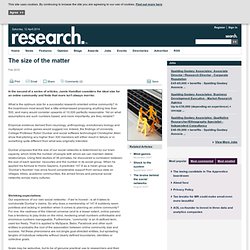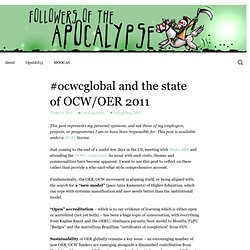

2011 The Year of Open « Paul Stacey. 2011 The Year of Open December 21, 2011, 2:08 pm Filed under: copyright, Open Educational Resources (OER) | Tags: copyright, creative commons, MOOC, OERU, open data, open educational resources, open faculty, open institutions, open pedagogies, open policy, open science, open students, UNESCO-COL Guidelines for Open Educational Resources The “open” space is expanding. 2011 has been a watershed year with open gaining traction and acceptance. photo by Paul Stacey Governments in Australia, the Netherlands, New Zealand, and the US have all adopted Creative Commons licenses to communicate broad reuse rights to the content, data, and educational materials they create.

Open practice. Open eaducational models. Open education and policy. MOOCs. The size of the matter. In the second of a series of articles, Jamie Hamilton considers the ideal size for an online community and finds that more isn’t always merrier.

What is the optimum size for a successful research-oriented online community? In the boardroom most would feel a little embarrassed proposing anything less than 500, and many would consider upwards of 10,000 perfectly reasonable. Yet on what assumptions are such numbers based, and more importantly, are they reliable? Empirical evidence derived from neurology, anthropology, evolutionary biology and multiplayer online games would suggest not. Indeed, the findings of University College Professor Robin Dunbar and social software technologist Christopher Allen show that pitching any higher than 300 members will either result in failure or in something quite different from what was originally intended.
Shrinking expectationsOur experience of our own social networks - if we’re honest - is all it takes to corroborate Dunbar’s claims. Follow us on. #ocwcglobal and the state of OCW/OER 2011 - Followers of the Apocalypse. This post represents my personal opinions, and not those of my employers, projects, or programmes I am or have been responsible for.

This post is available under a CC-BY license. Just coming to the end of a useful few days in the US, meeting with Ithaka S&R and attending the OCWC conference. As usual with such visits, themes and commonalities have become apparent: I want to use this post to reflect on these rather than provide a who-said-what style comprehensive account. Fundamentally, the OER/OCW movement is aligning itself, or being aligned with, the search for a “new model” (pace Anya Kamenetz) of Higher Education, which can cope with systemic massification and user needs better than the institutional model. Sustainability of OER globally remains a key issue – an encouraging number of new OER/OCW funders are emerging alongside a diminished contribution from Hewlett, with a range of different reasons for their activity, and a range of different foci and/or ideology.
(Un)related. Openness, Learning Analytics, and Continuous Quality Improvement. OER.
OU.